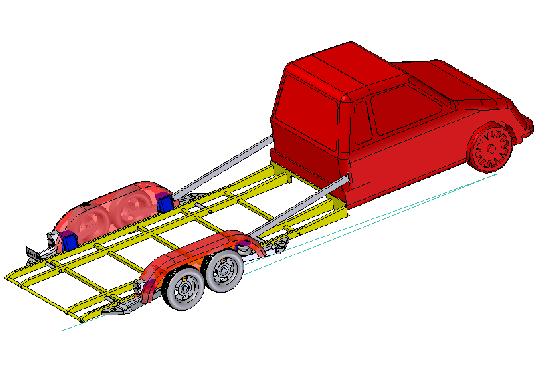Wear of suspension bushes has been a problem that has plagued vehicle manufacturers since the days of horse drawn coaches. To combat this wear modern automobiles use complex and expensive ‘ball joints” which, as long as the protective rubber boot covering them remains intact, last almost for ever.
However, as anyone who owns a utility trailer will know, wear in the pivot points of leaf springs is a constant problem.

One of the most interesting things that I have discovered in using my Carcamel for 10 years and 200K kilometers is the longevity of the suspension arm bush design that I came up with. I believe that with a little ingenuity this could be adapted to improve the reliability of almost any leaf spring or trailing arm suspension.
 Taken during construction this photo shows the general layout of the suspension arms. This is the left side forward “trailing” arm.
Taken during construction this photo shows the general layout of the suspension arms. This is the left side forward “trailing” arm.
Visible above, where the arrow indicates, is the 1 1/4″ schedule 80 pipe (pivot shaft) upon which the suspension arm pivots and the 2″ pipe on the end of the suspension trailing arm into which the 2 “top-hat” type Nylatron GSM suspension bushes are pressed; one in each end of the 2″ pipe.
 The outer rim of one of the outer Nylatron GSM suspension bushes can be seen in this photo. The arm itself is prevented from sliding off the pivot shaft by the keyhole shaped plate. This is the left side rear “leading” arm.
The outer rim of one of the outer Nylatron GSM suspension bushes can be seen in this photo. The arm itself is prevented from sliding off the pivot shaft by the keyhole shaped plate. This is the left side rear “leading” arm.
The bushes themselves are about 2 1/2″ long and are a “press” fit into the arm. Once installed in the arm the bushes become a “push” fit onto the pivot shaft. An “O” ring groove is machined into the outer end of the inside diameter of each bush to accommodate a standard rubber “O” ring. This “O” ring prevents the entry of moisture and dirt.
The big secret to this whole system is, I believe, the fact that the pivot shaft is galvanized. In fact the entire rear deck assembly including the suspension arms is galvanized.
 The completed and installed left front (trailing) arm assembly can be seen in this photo.
The completed and installed left front (trailing) arm assembly can be seen in this photo.
During assembly the pivot shafts and ID of the bushes were coated with wheel bearing grease and care was taken to ensure that the “O” rings remained in place. Provision was made to allow these pivot points to be lubricated during servicing but I have never actually done that.
In normal road use the arms only move through about 5 degrees of arc although the total available range of movement, limited by the extension of the shock absorbers, is about 26 degrees of arc.
Here is the amazing thing. When I initially installed the arms the bushes were tight enough to just prevent the arm from pivoting to allow the wheel and brake assembly to drop under its own weight when the chassis was raised. Now, after 200K kilometers and 10 years, the arm will still not quite drop under the influence of the weight of the wheel and brake assembly indicating that there has been absolutely no wear in the pivot.
I’m huge fan of “maintenance free” anything!!!
UPDATE


Write A Comment